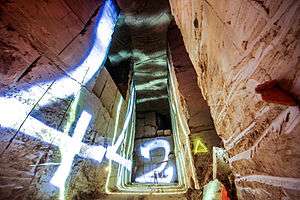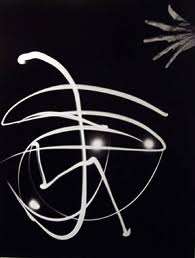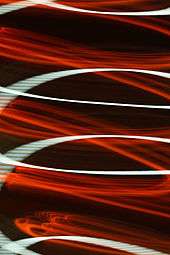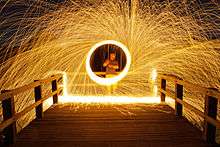Light painting

Light painting, or light drawing, is a photographic technique in which exposures are made by moving a hand-held light source while taking a long exposure photograph, either to illuminate a subject or to shine a point of light directly at the camera, or by moving the camera itself during exposure The technique is used for both scientific and artistic purposes, as well as in commercial photography.
History

Light painting, more specifically light drawing, dates back to 1889 when Étienne-Jules Marey and Georges Demeny traced human motion in the first known light painting “Pathological Walk From in Front”.[1] The technique was used in Frank Gilbreth's work with his wife Lillian Moller Gilbreth in 1914, when the pair used small lights and the open shutter of a camera to track the motion of manufacturing and clerical workers. Man Ray, in his 1935 series "Space Writing," was the first known art photographer to use the technique. Photographer Barbara Morgan began making light paintings in 1940.
In 1949 Pablo Picasso was visited by Gjon Mili, a photographer and lighting innovator, who introduced Picasso to his photographs of ice skaters with lights attached to their skates. Immediately Picasso started making images in the air with a small flashlight in a dark room. This series of photos became known as Picasso's "light drawings." Of these photos, the most celebrated and famous is known as "Picasso draws a Centaur"[2] Peter Keetman (1916–2005), who studied photography in Munich from 1935 to 1937, was the 1949 co-founder of FotoForm (together with Otto Steinert, Toni Schneiders et al.), a group with great impact on the new photography in the 50s and 60s in Germany and abroad. He produced a series Schwingungsfigur (oscillating figures) of complex linear meshes, often with moiré effects, using a point-source light on a pendulum.[3]
During the 1970s and 80's Eric Staller [4] used this technology for numerous photo projects that were called "Light Drawings". Light paintings up to 1976 are classified as light drawings. In 1977 Dean Chamberlain gave birth to light painting (using handheld lights to selectively illuminate and/or color parts of the subject or scene) with his image "Polyethylene Bags On Chaise Longue" at The Rochester Institute of Technology. Dean Chamberlain was the first artist to dedicate his entire body of work to the light painting art form.[1] The artist photographer Jacques Pugin made several series of images with the light drawing technique in 1979.[5] Picasso and Mili's images should be regarded as some of the first light drawings. Now, with modern light painting, one uses more frequently choreography and performance to photograph and organize.
In the 1970s and early 1980s, Steve Mann invented, designed, built, and used various wearable computers to visualize real-world phenomena such as sound waves, radio waves, and sight fields by light painting using computational photography.[6][7][8]
This artform enjoyed a surge in popularity in the 21st century, partly due to the increasing availability of dSLR cameras, advances in portable light sources such as LEDs, and also in part due to the advent of media sharing websites by which practitioners can exchange images and ideas.
Techniques

Light painting using handheld lights to selectively illuminate or colour parts of the subject or scene or to evenly light large architectural interiors has been used in professional photography since the 1930s as described by Leslie Walker[9] and Ansel Adams.[10] Light painting requires a slow shutter speed, usually at least a second in duration. Light painting can imitate characteristics of traditional painting; superimposition and transparency can easily be achieved by moving, adding or removing lights or subjects during or between exposures.
Light paintings can be created using a webcam. The painted image can already be seen while drawing by using a monitor or projector. Another technique is the projection of images on to irregular surfaces (such as faces or buildings), in effect "painting" them with light. A photograph or other fixed portrayal of the resulting image is then made.
Kinetic light painting is achieved by moving the camera, and is the antithesis of traditional photography. At night, or in a dark room, the camera can be removed from the tripod and used like a paintbrush. An example is using the night sky as the canvas, the camera as the brush and artificially-lit cityscapes as the palette. Putting energy into moving the camera by stroking lights, making patterns and laying down backgrounds can create abstract artistic images.
Equipment
A variety of light sources can be used, ranging from simple flashlights to dedicated devices like the Hosemaster, which uses a fiber optic light pen.[11] Other sources of light including candles, matches, fireworks, lighter flints, glowsticks, and Poi are also popular.
The PixelStick offer users the ability to control their light source in order to create images from letters to pictures that they have imported.
A tripod is usually necessary due to the long exposure times involved. Alternatively, the camera may be placed on or braced against a table or other solid support. A shutter release cable or self timer is generally employed in order to minimize camera shake. Color gels can also be used to color the light sources.
Some light painters make their own dedicated devices to create light trails over the photo background; this can include computer-controlled devices. This Arduino controlled LED array can render images that could not be made by drawing in the air with a single light source alone.
Gallery
-

Light Painting Screw, by Karsten Knöfler
-

Computational Lightpainting and wearable computational photography as a 3D gesture-based AR user-interface by Steve Mann
-

Orb created by swinging a light source, domes created by spinning a wheel with light source attached
-

Portrait illuminated by light painting with a sparkler
-

Stick figure image produced with light painting.
-

Light painting with steel wool
-

Urban Light Painting
-

Light painting with LEDs, by Beo Beyond
-
Light painting at a wedding
Important artists
- Jack Delano (1914–1997)
- Andreas Feininger (1906–1999)
- Georges Mathieu (1921–2012)
- Gjon Mili (1904–1984)
- Pablo Picasso (1881–1973)
- Man Ray (1890–1976)
- Eric Staller (born 1947)
- JanLeonardo (born 1970)
See also
- Available Light
- Light art performance photography
- Light art
- Glowsticking
- Fire dancing
- Night photography
- Kinetic photography
References
- 1 2 http://lightpaintingphotography.com/light-painting-history/
- ↑ ""Pablo Picasso" by Gjon Mili". VP Gallery. Retrieved 2008-12-23.
- ↑ Jäger, Gottfried; Reese, Beate; Krauss, Rolf H (2005), Concrete photography = Konkrete fotografie, Kerber Verlag, ISBN 978-3-936646-74-0
- ↑ Eric Staller - Light Drawings
- ↑ Light Painting historical article on the site of Light Painting World Alliance
- ↑ Campus Canada, ISSN 0823-4531: p55, Feb-Mar 1985; pp58-59, Apr-May 1986; and p72, Sep-Oct 1986.
- ↑ Impulse, ISSN 0315-3694 (Warning: Check ISSN), Volume 12, Number 2, 1985
- ↑ Mann, S. (1997). Wearable computing: A first step toward personal imaging. IEEE Computer, 30(2), pp25-32.
- ↑ Walker, Leslie C (1940), The technique of painting with light, The Nash-Jones publishing company, retrieved 17 March 2016
- ↑ Adams, Ansel; Baker, Robert; New York Graphic Society (1981), The negative (1st ed.), Little, Brown and Company, p. 174, ISBN 978-0-8212-1131-1
- ↑ Greenspun, Philip (January 2007). "Studio Photography". Photo.net. Retrieved 2007-09-26.
External links
| Wikimedia Commons has media related to Light painting. |
- Article in Amateur Photographer magazine on the fundamental basics of Light Painting
- Diverse light painting techniques by Michael Bosanko
- Light Painting World Alliance - non-profit organization united all light painters in the globe
- Painting with Light - How it all began - Historical article about light painting's roots
- Life Magazine - Behind the Photograph - about Pablo Picasso as he paints with light
- various style of natural light sourses - Moon, stars, fire
- International Light Painting Award | Bi-Annual, International Photo Competition For Light Painting